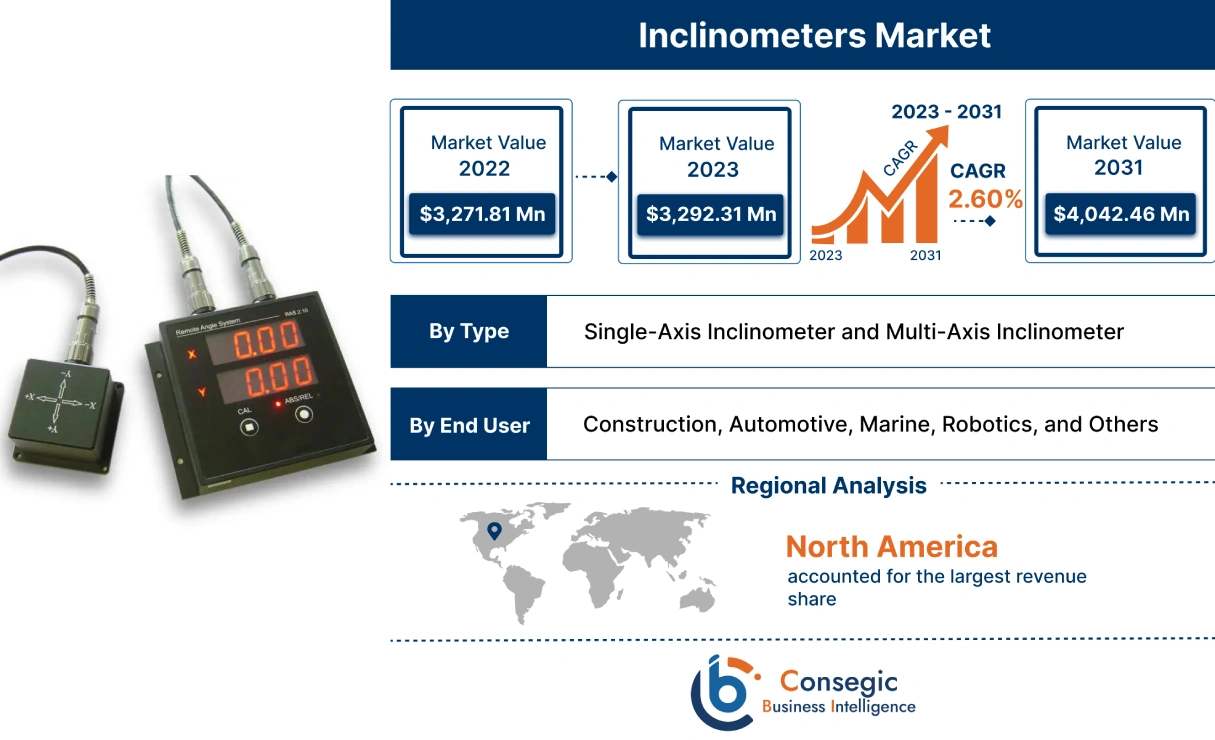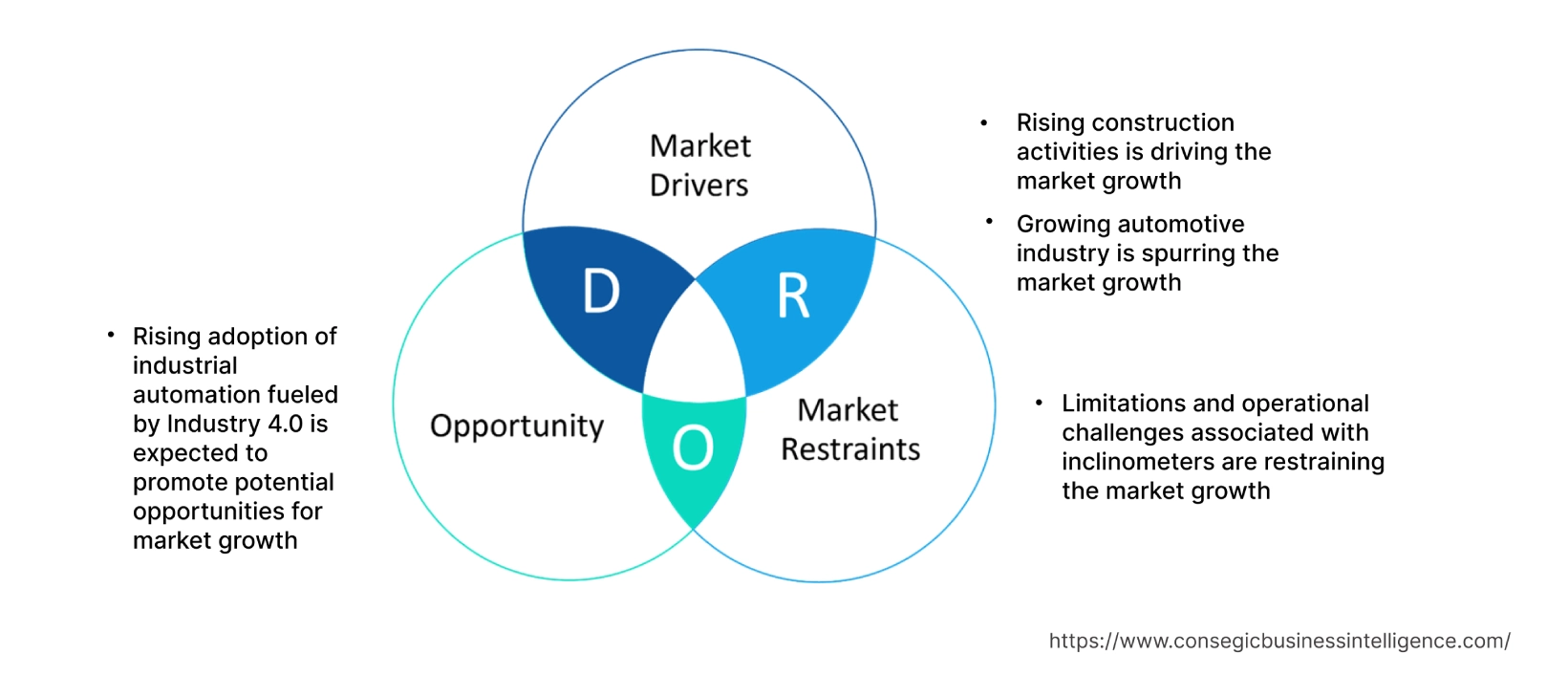Inclinometers Market Size :
Inclinometers Market is estimated to reach over USD 4,042.46 Million by 2031 from a value of USD 3,271.81 Million in 2022 and is projected to grow by USD 3,292.31 Million in 2023, growing at a CAGR of 2.60% from 2023 to 2031.
Inclinometers Market Scope & Overview:
Inclinometers refer to instruments that are designed for measuring the angles of tilt/slope and depression/elevation of an object with respect to gravity. The resulting measurement from inclinometers is either given in an angular measurement or as a percentage with reference to a level zero plane. Moreover, inclinometers are integrated with several features including high stability and repeatability, ultra-low power consumption, low noise, along with reliable, accurate, and high-resolution reading with long-term stability among others. The aforementioned features of inclinometers are key determinants for increasing their utilization in construction, automotive, marine, robotics, and other industries.
Inclinometers Market Insights :
Inclinometers Market Dynamics - (DRO) :
Key Drivers :
Rising construction activities is driving the market growth
Inclinometers are primarily used in the construction sector for monitoring stress relief ground movements and potential displacement of blocks during the construction activities. Inclinometers are also used for measuring the magnitude of tilt and differential deformation within the wall of building structure. Moreover, inclinometers are commonly used in inclination measurement and monitoring of building structure to ensure enhanced safety.
Factors including the increasing building and construction activities and rising investments in infrastructure development are among the key factors driving the growth of the construction sector.
For instance, according to the State of Nevada of the United States, new residential building permits reached 23,406 units in Nevada in 2021, representing a growth of nearly 19% in contrast to 19,716 units in 2020.
Additionally, according to Invest India, the Government of India made an investment of approximately USD 1.4 trillion on infrastructure development in 2023 under the NIP (National Infrastructure Pipeline) program. Thus, the growth of construction sector is increasing the adoption of inclinometers for inclination measurement and monitoring of building structure during construction activities, in turn driving the growth of the market.
Growing automotive industry is spurring the market growth
Inclinometers are used in the automotive industry for measuring the tilt, angle of the vehicle and variations in the right and left turning angle of the vehicle body to ensure safe driving. Moreover, inclinometers are integrated in automobiles for providing data including slopes which help users in understanding road conditions and increase driving safety. The integration of inclinometers in automobiles helps in precise monitoring of vehicle angle for autonomous driving and ADAS (advanced driver assistance system) applications among others.
Factors including advancements in autonomous driving systems, increasing automobile production, and growing demand for enhanced automotive safety solutions are vital aspects driving the growth of the automotive industry.
According to the International Organization of Motor Vehicle Manufacturers, the total automotive production across the world reached 85.01 million in 2022, representing an incline of 6% in contrast to 80.14 million in 2021.
Additionally, according to the European Automobile Manufacturers Association, the total passenger car production in the Europe Union reached 10.9 million in 2022, depicting an incline of 8.3% as compared to 2021. Therefore, the rising automobile production is increasing the utilization of inclinometers for precise monitoring of vehicle angle for autonomous driving and ADAS applications, in turn proliferating the market growth.
Key Restraints :
Limitations and operational challenges associated with inclinometers are restraining the market growth
The utilization of inclinometers is usually associated with few limitations and operational challenges, which is a key factor limiting the market growth.
For instance, traditional inclinometers have several limitations including electromagnetic interference, gravity dependence, signal loss for long distance transmission, and poor durability.
Moreover, the other limitation of inclinometers includes the ability to measure only horizontal ground deformations. Additionally, inclinometers are highly prone to systematic errors caused due to various factors including acute instrument warm-up drift, probable calibration hysteresis, borehole tendency to drift from vertical position, and larger distance coverage from the top reference point. Therefore, the aforementioned limitations and operational challenges associated with inclinometers are constraining the growth of the market.
Future Opportunities :
Rising adoption of industrial automation fueled by Industry 4.0 is expected to promote potential opportunities for market growth
The rising adoption of industrial automation is projected to present potential opportunities for the growth of the inclinometers market. Industry 4.0 enabled manufacturing represents automation readiness, extreme flexibility, highest productivity, and minimal human intervention in industrial processes. Moreover, the deployment of inclinometers in industrial sector plays a crucial role in inclination measurements in Industry 4.0 applications. Inclinometers combine several characteristics including high stability, low noise, repeatability, and ultra-low power consumption with support for Artificial Intelligence (AI) to facilitate industrial automation.
Factors including the growing pace of industrialization, rising investments in expansion of industrial manufacturing facilities, and increasing trend of industrial automation fueled by Industry 4.0 are anticipated to stimulate lucrative growth aspects for the market.
For instance, the government of Germany launched the "Industry 4.0" initiative that aims at promoting the development of digital technologies in manufacturing. The initiative further aims at supporting automation in manufacturing along with enhancing Germany's competitiveness in the manufacturing industry. Therefore, the rising government initiatives towards industrial automation is anticipated to increase the deployment of inclinometers for inclination measurements in Industry 4.0 applications to enhance operational efficiency, in turn promoting opportunities for market growth during the forecast period.
Inclinometers Market Report Insights :
| Report Attributes | Report Details |
| Study Timeline | 2017-2031 |
| Market Size in 2031 | USD 4,042.46 Million |
| CAGR (2023-2031) | 2.60% |
| By Type | Single-Axis Inclinometer and Multi-Axis Inclinometer |
| By End-User | Construction, Automotive, Marine, Robotics, and Others |
| By Region | North America, Europe, Asia-Pacific, Latin America, and Middle East & Africa |
| Key Players | Murata Manufacturing Co. Ltd., STMicroelectronics, TE Connectivity, Durham Geo-Enterprises Inc., Sherborne Sensors, GEOKON, Tokyo Measuring Instruments Laboratory Co. Ltd, Rieker Inc., Analog Devices Inc., Automation Sensorik Messtechnik GmbH, The Fredericks Company, RST Instruments Ltd. |
Inclinometers Market Segmental Analysis :
By Type :
Based on the type, the market is bifurcated into single-axis inclinometer and multi-axis inclinometer. The multi-axis inclinometer segment accounted for the largest revenue share in the year 2022. The multi-axis inclinometers are capable of measuring the angular changes in both X-axis and the Y-axis. Multi-axis inclinometers consist of two or more sensing elements placed at a 90-degree angle to each other. Each of the sensing elements has an output deduced by its tilt angle from the vertical about an axis. Moreover, multi-axis inclinometers offer several benefits including high accuracy, faster response time, and high level of precision among others. The above benefits of multi-axis inclinometers are primary determinants for increasing its utilization in construction, automotive, marine, robotics, and other sectors.
For instance, Murata Manufacturing Co. Ltd. introduced 3-axis inclinometers integrated with a tilt angle output and digital SPI interface in November 2018. The multi-axis inclinometers are optimized for demanding applications including tilt sensing, machine control, levelling, and structural health monitoring in construction and other industrial sectors. Hence, the rising innovations associated with multi-axis inclinometers are driving the growth of the market.
The single-axis inclinometers segment is anticipated to register the fastest CAGR growth during the forecast period. Single-axis inclinometers are designed for measuring angular changes around one axis only. The measurement principle of single-axis inclinometers is based on Newton's second law that utilizes the principle of inertia for measuring the acceleration of an object. Additionally, single-axis inclinometers are used in construction, power generation, and other industries.
For instance, The Fredericks Company introduced a single-axis inclinometer, ApexOne in its product portfolio. The single-axis inclinometer is designed for industrial position and angle measurement applications for utilization in construction, power generation, and other industries. Therefore, the increasing development of single-axis inclinometers for industrial applications is among the vital factors expected to drive the growth of the market during the forecast period.
By End-User :
Based on the end-user, the market is segregated into construction, automotive, marine, robotics, and others. The construction segment accounted for the largest revenue share of 32.5% in the year 2022. Factors including the rising building and construction activities and increasing investments in infrastructure development are driving the growth of the construction segment.
For instance, STMicroelectronics offers multi-axis inclinometer IIS2ICLX in its product portfolio that is primarily designed for utilization in construction sector for structural health monitoring application among others.
Additionally, according to the Building and Construction Authority of Singapore, the overall construction demand in Singapore is estimated to reach between USD 27 billion to USD 32 billion by the end of 2023, representing a substantial growth as compared to 2020. Therefore, the growing construction sector is driving the adoption of inclinometers for inclination measurement and monitoring of building structure, in turn driving the growth of the market.
Automotive segment is expected to witness fastest CAGR growth during the forecast period. The growth of automotive segment is driven by multiple factors including increasing automobile production, rising investments in expansion of automotive production facilities, and advancements in autonomous driving systems among others.
For instance, Murata Manufacturing Co. Ltd. offers SCA830 single-axis inclinometers in its product portfolio that are specifically designed for inclination measurements in automotive applications.
Additionally, according to the China Association of Automobile Manufacturers, passenger car manufacturing in China reached 14.8 million units in January-August 2022, witnessing a progression of 14.7% year-over-year. Inclinometers are used in the automotive industry, particularly for precise monitoring of vehicle angle for autonomous driving and ADAS applications to ensure safe vehicle operations. Thus, rising automotive production is projected to drive the adoption of inclinometers, in turn contributing the market growth during the forecast period.
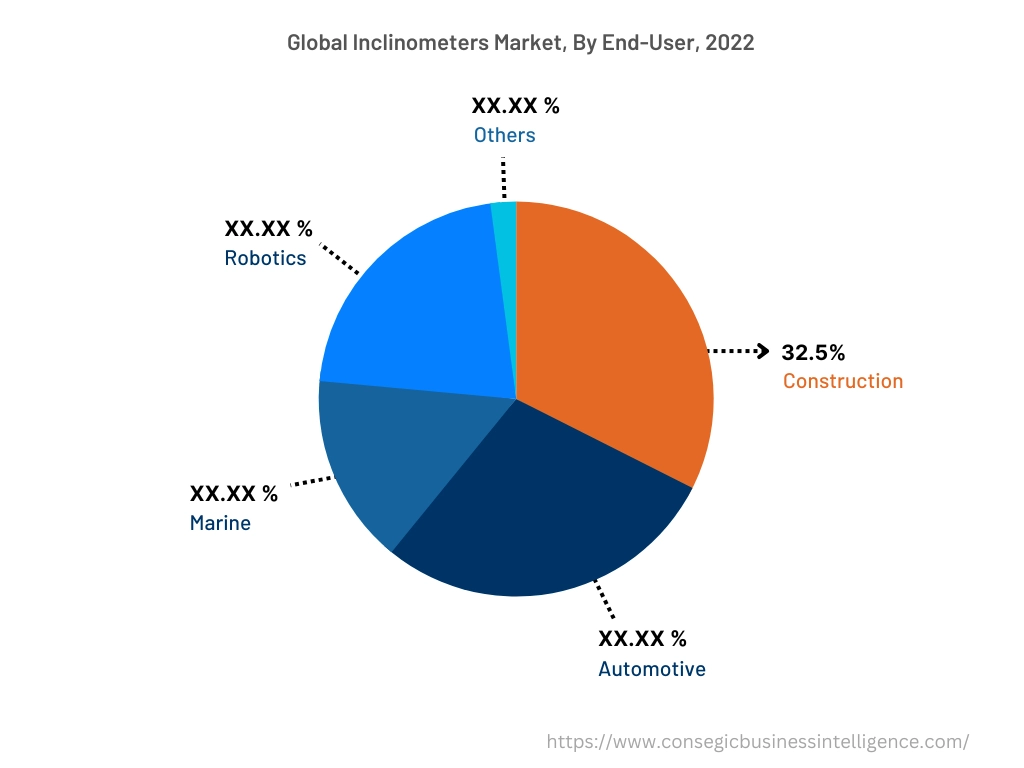
By Region :
The regional segment includes North America, Europe, Asia Pacific, Middle East and Africa, and Latin America.
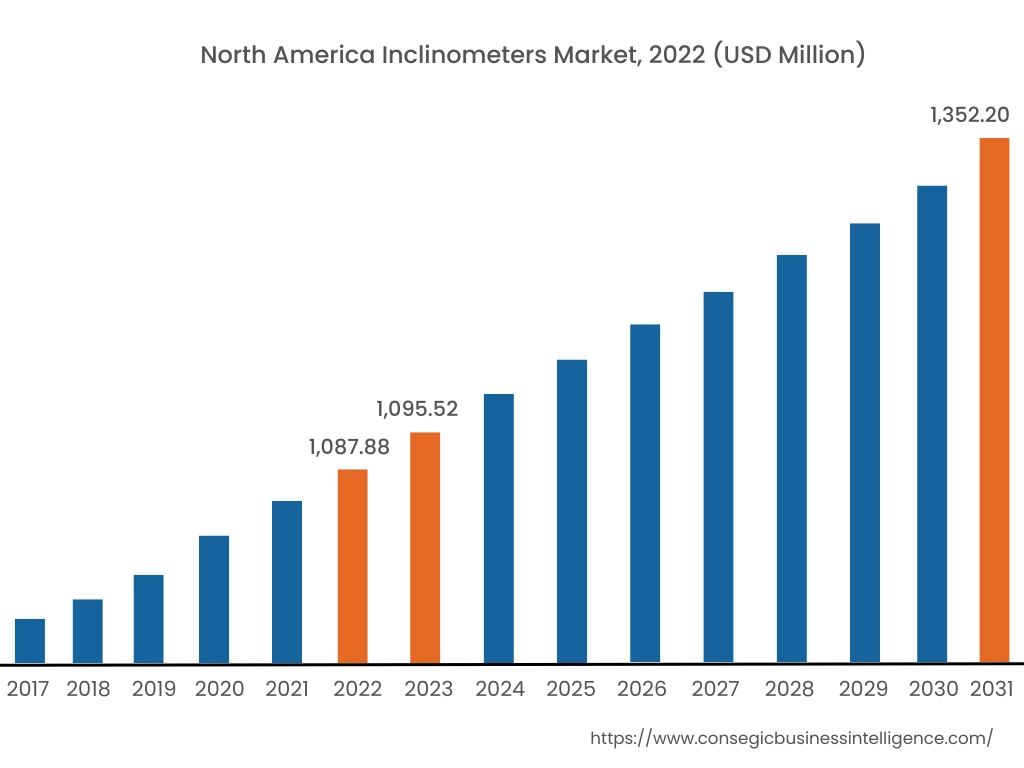
North America accounted for the largest revenue share of USD 1,087.88 Million in 2022 and is expected to reach USD 1,352.20 Million by 2031, registering a CAGR of 2.7% during the forecast period. Also, the market is projected to garner revenue of USD 1,095.52 million in the year 2023. In addition, in the region, the U.S. accounted for the maximum revenue share of 66.65% in the same year. The adoption of inclinometers in the North American region is primarily driven by its usage in construction, automotive, robotics, and other sectors. Moreover, the rising investments in building and construction projects and increasing utilization of inclinometers for inclination measurement and monitoring of building structure during construction activities are among the significant factors driving the market growth in the region.
For instance, according to Statistics Canada, investments in the building & construction sector reached USD 20.4 billion in January 2023, representing an increase of 1.5% in comparison to the previous year. Moreover, investments in the residential sector in Canada increased by 1.9% to USD 14.9 billion, while the non-residential sector increased by 0.5% to USD 5.6 billion in January 2023. Thus, the growing construction industry is driving the deployment of inclinometers, in turn fostering market growth in the North American region. Additionally, increasing investments in the field of electric vehicles and robotics are expected to facilitate lucrative growth prospects for the market in North America during the forecast period.
Asia-Pacific is expected to register fastest CAGR growth of 2.9% during the forecast period. The rising pace of industrialization and development is stimulating lucrative growth prospects for the market in the region. Additionally, factors including the growth of multiple industries such as automotive, construction, and others along with rising adoption of industrial automation are driving the market growth for inclinometers in the Asia-Pacific region.
For instance, according to the Society of Indian Automobile Manufacturers, the overall automobile production in India reached 2,59,31,867 units from April 2022 to March 2023, depicting an incline of 12.6% from 2,30,40,066 units from April 2021 to March 2022. Therefore, the growing automotive sector is anticipated to drive the utilization of inclinometers for precise monitoring of vehicle angle for autonomous driving and ADAS applications to facilitate safe vehicle operations. The above factors are projected to drive the market growth in the Asia-Pacific region during the forecast period.
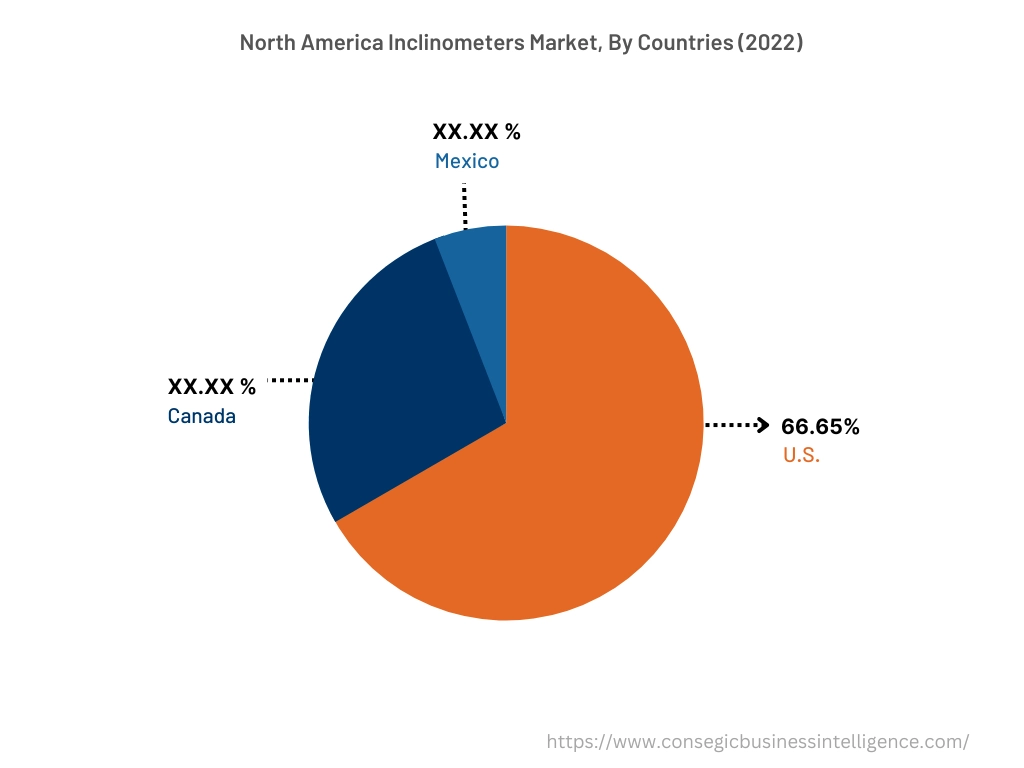
Top Key Players & Market Share Insights:
The inclinometers market is highly competitive with major players providing inclinometers to the national and international markets. Key players are adopting several strategies in research and development (R&D), product innovation, and end-user launches to hold a strong position in inclinometers market. Key players in the inclinometers market include-
- Murata Manufacturing Co. Ltd.
- STMicroelectronics
- Analog Devices Inc.
- Automation Sensorik Messtechnik GmbH
- The Fredericks Company
- RST Instruments Ltd.
- TE Connectivity
- Durham Geo-Enterprises Inc.
- Sherborne Sensors
- GEOKON
- Tokyo Measuring Instruments Laboratory Co. Ltd
- Rieker Inc.
Recent Industry Developments :
- In August 2020, STMicroelectronics launched its new 2-axis digital inclinometer IIS2ICLX, integrated with high-accuracy and low-power consumption. The 2-axis digital inclinometer is designed for utilization in applications including structural-health monitoring and industrial automation among others.
Key Questions Answered in the Report
What is inclinometers? +
Inclinometers refer to instruments that are designed for measuring the angles of tilt/slope and depression/ elevation of an object with respect to gravity.
What specific segmentation details are covered in the inclinometers report, and how is the dominating segment impacting the market growth? +
For instance, by type segment has witnessed multi-axis inclinometers as the dominating segment in the year 2022, owing to its increasing utilization in construction, automotive, robotics, and other sectors.
What specific segmentation details are covered in the inclinometers market report, and how is the fastest segment anticipated to impact the market growth? +
For instance, by end-user segment has witnessed automotive as the fastest-growing segment during the forecast period due to rising adoption of inclinometers in automotive sector for precise monitoring of vehicle angle for autonomous driving and ADAS (advanced driver assistance system) applications among others.
Which region/country is anticipated to witness the highest CAGR during the forecast period, 2023-2031? +
Asia-Pacific is anticipated to register fastest CAGR growth during the forecast period due to rapid pace of industrialization, growth of multiple industries such as automotive, construction, and others along with rising adoption of industrial automation.
